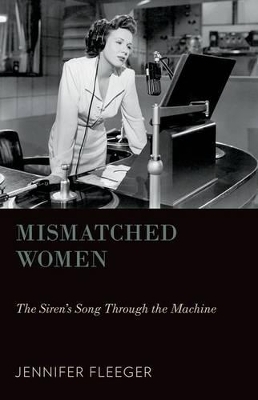
Mismatched Women
The Siren's Song Through the Machine
Seiten
2014
Oxford University Press Inc (Verlag)
978-0-19-993691-5 (ISBN)
Oxford University Press Inc (Verlag)
978-0-19-993691-5 (ISBN)
This book tells the history of sound machines through singers whose bodies and voices do not match. Jennifer Fleeger explores this phenomenon, moving from the fictional Trilby to the real-life Youtube star Susan Boyle, and demonstrating along the way that singers with voices that do not match their bodies are essential to the success of technologies for preserving and sharing music.
In 2009, Susan Boyle's debut roused Simon Cowell from his grumbling slumber on the television show "Britain's Got Talent" and viewers across the world rallied to the side of the unemployed, older woman with the voice of a trained Broadway star. In Mismatched Women, author Jennifer Fleeger argues that the shock produced when Boyle began to sing belies cultural assumptions about how particular female bodies are supposed to sound. Boyle is not an anomaly, but instead belongs to a lineage of women whose voices do not "match" their bodies by conventional expectations, from George Du Maurier's literary Trilby to Metropolitan Opera singer Marion Talley, from Snow White and Sleeping Beauty to Kate Smith and Deanna Durbin.
Mismatched Women tells a new story about female representation in film by theorizing a figure regularly dismissed as an aberration. The mismatched woman is a stumbling block for both sound and feminist theory, argues Fleeger, because she has been synchronized yet seems to have been put together incorrectly, as if her body could not possibly house the voice that the camera insists belongs to her. Fleeger broadens the traditionally cinematic context of feminist psychoanalytic film theory to account for literary, animated, televisual, and virtual influences. This approach bridges gaps between disciplinary frameworks, showing that studies of literature, film, media, opera, and popular music pose common questions about authenticity, vocal and visual realism, circulation, and reproduction. The book analyzes the importance of the mismatched female voice in historical debates over the emergence of new media and unravels the complexity of female representation in moments of technological change.
In 2009, Susan Boyle's debut roused Simon Cowell from his grumbling slumber on the television show "Britain's Got Talent" and viewers across the world rallied to the side of the unemployed, older woman with the voice of a trained Broadway star. In Mismatched Women, author Jennifer Fleeger argues that the shock produced when Boyle began to sing belies cultural assumptions about how particular female bodies are supposed to sound. Boyle is not an anomaly, but instead belongs to a lineage of women whose voices do not "match" their bodies by conventional expectations, from George Du Maurier's literary Trilby to Metropolitan Opera singer Marion Talley, from Snow White and Sleeping Beauty to Kate Smith and Deanna Durbin.
Mismatched Women tells a new story about female representation in film by theorizing a figure regularly dismissed as an aberration. The mismatched woman is a stumbling block for both sound and feminist theory, argues Fleeger, because she has been synchronized yet seems to have been put together incorrectly, as if her body could not possibly house the voice that the camera insists belongs to her. Fleeger broadens the traditionally cinematic context of feminist psychoanalytic film theory to account for literary, animated, televisual, and virtual influences. This approach bridges gaps between disciplinary frameworks, showing that studies of literature, film, media, opera, and popular music pose common questions about authenticity, vocal and visual realism, circulation, and reproduction. The book analyzes the importance of the mismatched female voice in historical debates over the emergence of new media and unravels the complexity of female representation in moments of technological change.
Jennifer Fleeger is an Assistant Professor in the Department of Media and Communication Studies at Ursinus College where she teaches courses in the film studies program. Her first book, Sounding American: Hollywood, Opera, and Jazz, also appears in Oxford's Music/Media Series.
Introduction ; Chapter 1: Literary Divas: Trilby, Christine, and the Phantom of Phonography ; Chapter 2: Metropolitan Women: Geraldine Farrar and Marion Talley Silence Opera on Screen ; Chapter 3: Opera in Synch: Deanna Durbin and Musical Playback ; Chapter 4: The Disney Princess: Animation and Real Girls ; Chapter 5: Kate Smith: The Variety "Femcee" on Radio and Television ; Chapter 6: Susan Boyle: The Amateur in the Age of Auto-Tune ; Conclusion ; Bibliography
| Reihe/Serie | Oxford Music/Media Series |
|---|---|
| Verlagsort | New York |
| Sprache | englisch |
| Maße | 231 x 155 mm |
| Gewicht | 363 g |
| Themenwelt | Kunst / Musik / Theater ► Allgemeines / Lexika |
| Kunst / Musik / Theater ► Film / TV | |
| Kunst / Musik / Theater ► Musik ► Klassik / Oper / Musical | |
| Sozialwissenschaften ► Kommunikation / Medien ► Medienwissenschaft | |
| Sozialwissenschaften ► Soziologie ► Gender Studies | |
| ISBN-10 | 0-19-993691-9 / 0199936919 |
| ISBN-13 | 978-0-19-993691-5 / 9780199936915 |
| Zustand | Neuware |
| Haben Sie eine Frage zum Produkt? |
Mehr entdecken
aus dem Bereich
aus dem Bereich
wie wir unsere Musikkultur retten
Buch | Hardcover (2023)
Frankfurter Allgemeine Buch (Verlag)
CHF 38,90


